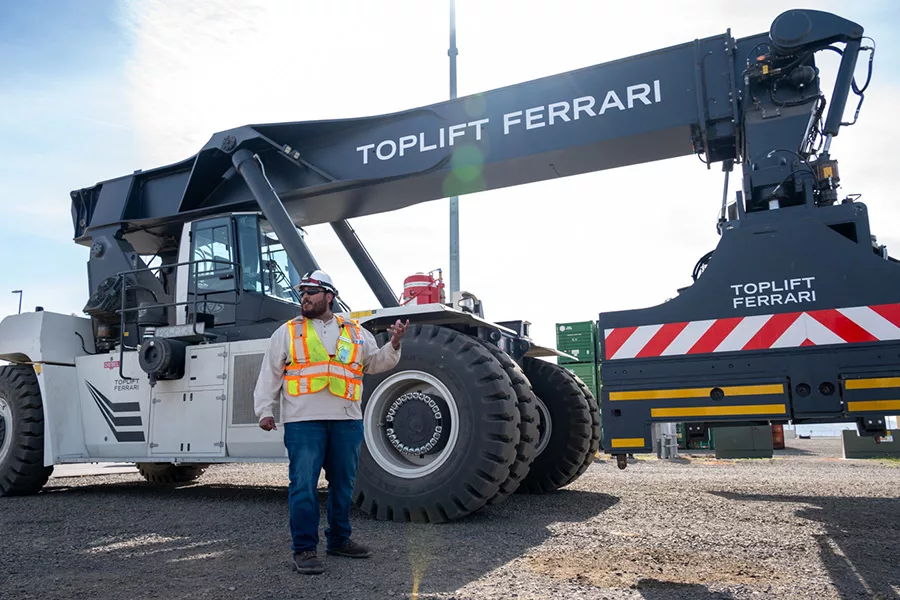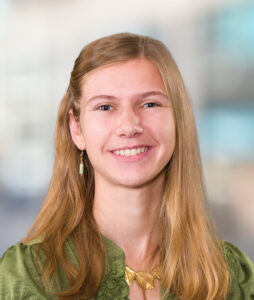
Home » ‘Fragile’ manufacturing industry faces several challenges
‘Fragile’ manufacturing industry faces several challenges

Narciso Sepulveda of Tri-Cities Intermodal shows local high school students one of the company's Ferrarisa, a Toplift Ferrari, imported from Italy. This vehicle, a 2022 model, can lift 98,000 pounds. Tri-Cities Interomdal was founded in November 2023 and offers a unique logistics hub in Wallula. By converting highway movements to rail, it simultaneously reduces highway congestion and lower greenhouse gas emissions while reducing cost and complexity for manufacturers and anyone else shipping goods east or west. AWB visited their facilities on Oct. 3, during the second day of the eighth annual Manufacturing Week bus tour.
Courtesy Brian Mittge / AWBOctober 14, 2024
Taxes, regulations, energy and workforce remain some of the manufacturing industry’s major challenges despite an increase in manufacturing jobs throughout the state.
The Association of Washington Business’ 2024 State of Manufacturing in Washington address took a look at some of this year’s successes and concerns in the manufacturing industry.
The event at Lampson International headquarters in Kennewick was part of AWB’s eighth annual Manufacturing Week bus tour.
The manufacturing tour is “a great reminder that we’re all connected in this economy together,” said AWB President Kris Johnson, who gave the address.
The bus trip was scheduled to visit 25 manufacturers across the state, including three in the Tri-City region, during its weeklong tour highlighting the importance of manufacturing in Washington.
Washington’s products, including planes, wine and the Mid-Columbia region’s french fries, are seen throughout the world. And they impact communities around the state as well.
“Throughout Washington state and right here in the Tri-Cities, the manufacturing sector has built our economy,” Johnson said. “Companies like Lampson International, Simplot, Lamb Weston, just to name a few, have lifted our standard of living and strengthened the communities that we call home.”
Doubling manufacturing
Johnson characterized the manufacturing industry in Washington as “strong and resilient … but it is also fragile, and we cannot take that success for granted.”
Washington gained 5,100 new manufacturing jobs last year, he said, bringing the total up to 271,000 in the state. That increase isn’t just helpful for the manufacturing industry, but for communities in general.
“Every one job in manufacturing, it supports three other jobs in the local community,” Johnson said. “So nearly a million Washingtonians are supporting this really important sector.”
The recent job growth is positive, but it’s far from a statewide goal set three years ago to double manufacturing jobs, Johnson said. The state also wants to double the number of small businesses and the number of women and minority-owned manufacturing businesses in the next 10 years.
Manufacturers continue to report that their main challenges stem from the state’s taxes and regulations.

Todd Brix is CEO of OCOchem, which he founded in 2020. The company employs 17 people in Richland and manufactures formate chemicals made from carbon dioxide. OCOchem is pioneering the electrochemical conversion of carbon dioxide into useful chemicals and materials at a lower cost than the conventional fossil-based pathway. OCOchem has built and operates the world's largest CO2 electrolyzer in Richland. The company is supported by a global array of private investors, the U.S. Department of Energy and the U.S. Army. For every pound of product OCOchem makes, 7.2 pounds of CO2 emissions are abated, making carbon regeneration seven times more effective that CO2 sequestration. AWB visited its facilities on Oct. 3, during the second day of the eighth annual Manufacturing Week bus tour.
| Courtesy Brian Mittge / AWBDoubling manufacturing jobs is “a big goal,” Johnson said. “It’s a good goal, and it’s one that we may not achieve even if every decision we make is the right decision, but we have no chance at all if elected officials and leaders and policymakers continue to add tax and regulatory burden challenges.”
During a “fireside chat” held immediately following the address, state Sen. Matt Boehnke, R-Kennewick, said that the bill aiming to double manufacturing also seeks to bring women and minorities to the forefront.
“Let’s get women in charge,” he said. “Women need to be at the head of the site. And even in the local community, how about our minorities, with the Asian population we have in Seattle, but here locally, with our Latino population, get them at the front of the line, not at the table, but at the front of the table.”
Legislative priorities
Johnson emphasized AWB’s role in advocating for manufacturing, including calling on legislators to support the industry.
Key to the success of manufacturing is energy production, research and development tax credits, permitting reform, developing infrastructure and investing in the next generation, he said.
Hydroelectric power gives Washington a competitive advantage that needs to be protected, Johnson said, while also pursuing other sources of energy.
“How are we going to keep up with the current demand and plan for future growth if we’re eliminating energy sources?” he said. “The only way we can possibly keep the lights on is by focusing on energy generation of every type.”

AWB visited Lampson International’s production facility in Pasco to see the maintenance facility that supports their crane manufacturing operations. Founded in 1946, the family-owned company employs 300 people worldwide. Among its many products, Lampson manufacturers the largest land-based crawler crane in the world. It designed and built its distinctive headquarters building in Kennewick. Lampson International is a third-generation family-owned operated business. AWB visited their facilities on Oct. 3, during the second day of the eighth annual Manufacturing Week bus tour.
Kate Lampson, Lampson International’s director of business development and strategic communication, echoed the need to “have all types of energy moving forward. We need wind, we need solar, nuclear, including small modular reactors, and battery power to really support this community.”
“We don’t want any brown-outs, blackouts or problems with our grid reliability,” Boehnke said. “We need to have that reliability there. We need to have that expansion.”
And to get materials, people and products everywhere they need to go, the infrastructure needs to be strengthened.
U.S. Rep. Dan Newhouse, R-Washington, highlighted the importance of rivers and dams beyond producing energy. “Fifty-five percent of the wheat that is produced in the United States moves down the Snake and Columbia rivers,” he said. And barges have a much larger capacity than trucks and trains.
Infrastructure development also includes roads, ports, rail, trucks and airports. “We need it all, because it’s a system that takes that complete system working together to move our economy forward,” Johnson said.
A research and development tax credit would help “reach down and lift up our smallest manufacturers,” Johnson said, while permitting reform would “make it easier for manufacturers to expand and build new facilities.”
Finally, the manufacturing industry needs a strong workforce, which includes investing in programs that help train the next generation.
That’s one thing Lampson International is working on through career fairs and tours, Lampson said.
“There are tremendous great careers that exist within the manufacturing sector. So we want young people to be equally as excited about this sector as we are,” Johnson said.
‘Invest in all parts’
The closure of the Lamb Weston plant in Connell is a reminder not to take the manufacturing sector for granted, Johnson said.
“We need to continue to be making smart, prudent decisions from investments and infrastructure,” he said.
It’s also a reminder that the manufacturing sector is a part of a system with many different parts. In the case of Lamb Weston, that’s not only the people who worked for the plant, but the potato growers and trucking companies transporting the potatoes.
“We need to take care of all parts of the system and invest in all parts of the system along the way,” Johnson said.
That includes some of the priorities AWB has for the Legislature: workforce, regulatory environment, energy and supply chain.
“It’s a combination of a lot of factors that typically go into decisions like this, and so for us, we need to be mindful of that too as we think about the solution for it,” he said.
Latest News Local News Food Processing Manufacturing
KEYWORDS October 2024
Related Articles
Related Products





